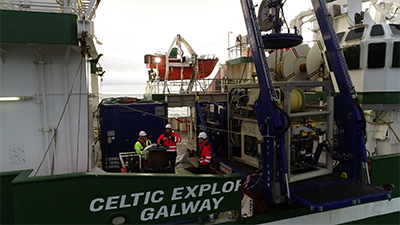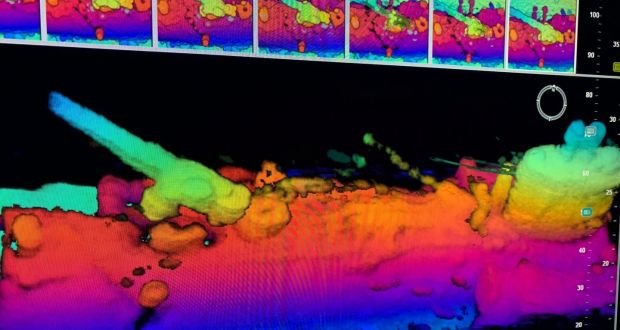ROV Equipped with SubC Camera Maps World War Era Shipwrecks
Above: ROV Étáin, deployed from the Research Vessel Celtic Explorer, is used to carry out the surveys in highly challenging environments.
Engineers from CRIS (Centre for Robotics and Intelligent Systems) at the University of Limerick have developed a highly functional Remotely Operated Vehicle (ROV), nicknamed Étáin. Launched in 2018, it features elements of SubC’s Survey System: the 1Cam and Digital Video Recorder (DVR) with Overlay. ROV Étáin can carry out surveys in challenging wind, wave, and tidal conditions. It can also be used to inspect, repair and maintain Marine Renewable Energy (MRE) facilities.
Three Shipwrecks Located
ROV Étáin was used in a mission to gather high-definition footage and build a 3D model of unknown shipwrecks off the Irish Coast. The survey was able to successfully locate and gather footage from three shipwreck sites between 80 and 200 meters below the surface. They are thought to be a World War I era ocean liner SS Canadian, a German U-Boat, and an armed cargo vessel.
The SS Canadian was sunk on a voyage from Boston to Liverpool in 1917 and the large debris field that was discovered suggests a violent impact with the seabed. The German U-Boat, U-58, was sunk by US destroyer Fannin, also in 1917. Most of the German crew survived and were interned in America until the end of the war.
Above: 3D model of German U-Boat, U-58, that sank off the Irish Coast.
Unexpected Discovery
In addition to mapping shipwrecks, the ROV was used to investigate the habitats that have formed on these wrecks over the past 100 years. The team discovered and captured footage of the structures being colonized by epifauna, including anemones, solitary corals, oysters, and brachiopods. The discovery of Lophelia pertusa was among the survey’s biggest surprises because this stony coral species is normally found in much deeper and colder water at 500 meters.
Above: Structure of a WW1 era ship with reef forming cold water coral growing. This photo was taken with SubC’s 1Cam.
The find suggests that wrecks may provide the stability needed for deep-water corals to thrive in shallower waters. In an article with the Irish Examiner, ocean scientist Anthony Grehan noted that sunken structures not only act as artificial reefs but “make an important contribution to maintaining coral and other species”. He also described these shipwrecks as “stepping stones for further colonization or restoration of damaged habitats”.
Another Survey, Another Shipwreck
During a seperate survey, the CRIS team inspected the SS Justicia, a British troopship that sank during the First World War. The SS Justicia’s precise movements are difficult to trace, as her activities were largely kept secret during the war. Unfortunately, the SS Justicia was torpedoed six times on July 19, 1918. The wreck of the SS Justicia lies 28 miles north-west of Malin Head, Ireland at a depth of 223 feet.
Above: The remains of the SS Justicia lie near the northernmost point of the island of Ireland, the Malin Head, at a depth of 68 m.
“Second to None” Equipment
When speaking about SubC Imaging and the 1Cam used on the Étáin, Anthony Weir, ROV Operator says, “the quality of the video and images achieved with their cameras is second to none. The camera housings, penetrators and whips are bulletproof and have never let us down…The SubC Imaging crew are a dynamic, no-nonsense crew who know their business and products. They are honest with their feedback when discussing how their products can be improved.”
From Shipwrecks to Ship Repair
The CRIS team at the University of Limerick are currently working on research project RESURGAM which will enable ship repair beneath the waterline at sea using Friction Stir Welding (FSW). FSW is a high integrity, low distortion, environmentally benign, welding technique that will allow ships damaged anywhere in the world to have the option of being repaired in place without the need to travel to the nearest dry dock.




